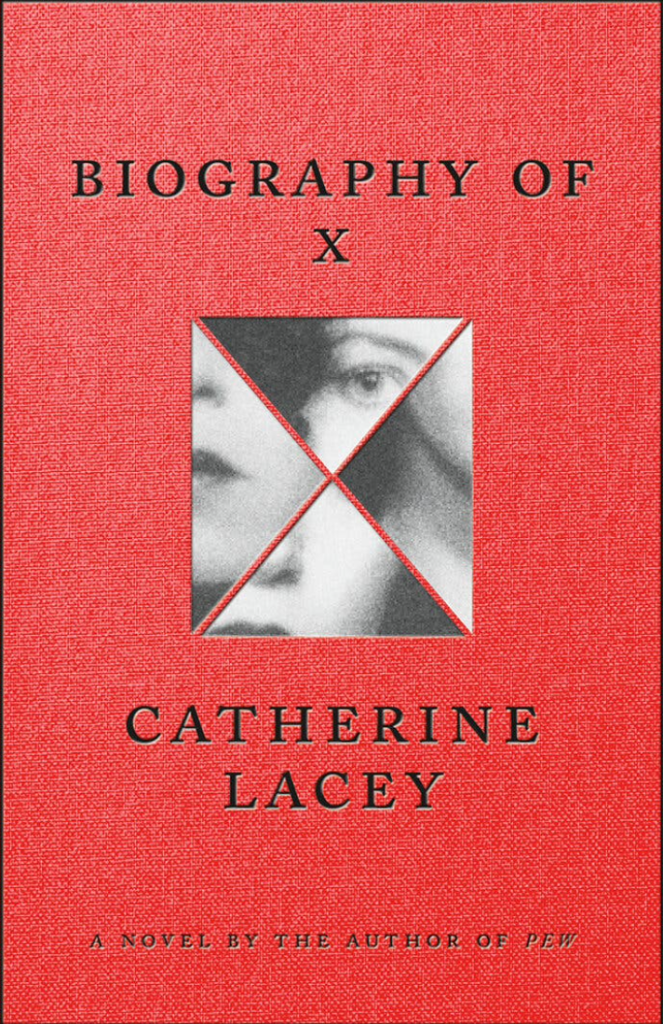
Catherine Lacey’s novel Biography of X grapples with so much at once that it’s difficult to even begin to cover it all.
On one level, it is a memoir of grief as the narrator tries to come to an understanding of her late wife’s life, both with and before her.
But her wife, named X, is also a complicated public figure, an iconoclastic artist with a history of taking on multiple personas. Through the exploration of X’s life as an artist, we often have to wonder if there is a real person beneath the roles X adopts for her various projects, beyond the parts she plays in contrived scenarios of her own making. For much of the book, she seems more artifice than artist.
These dimensions alone would make Biography of X a complex and layered novel to decode, but Lacey goes further in constructing the story. X’s fictional history as an artist intersects with a myriad of real-life artists from the last several decades, from Postmodern figures like Kathy Acker to pop stars like David Bowie. As the narrator reconstructs X’s life, Lacey appropriates real quotes and events from these figures and insinuates X within them. For example, X is credited as a contributor on some of Bowie’s most famous songs, including writing “Heroes.” Lacey then has X appropriate Bowie’s controversial ravings about fascism from the late 70’s, taking Bowie’s problematic ideas into herself like some kind of sin eater. (The exhaustive and impressive research for all this is documented in the appendix.)
But Lacey doesn’t just reimagine the history of art, music, and literature. X’s life and our narrator’s journey to recount it takes place in an alternate America, one where the stark ideological divides of our day were presaged by a physical separation. In the world of the novel, America split after WW II with the South breaking away as a harsh theocracy and the North evolving into a socialist state with Utopian goals—if not quite Utopian results.
Just as X’s fictional interposition amongst a who’s-who of American artists from the back half of the twentieth century allows Lacey to explore the dynamics and origins of creativity, X’s relationship to the divided alternate America opens questions about the role of trauma in identity—and its limits. Our narrator’s understanding of X as she peels back layer after layer also unveils the boundaries of America’s mythos and the ebbing and waning tides of political ideology in American life.
Throughout, Lacey’s prose is highly aphoristic; the narrator spools off insights like “Grief has a warring logic; it always wants something impossible, something worse and something better,” and “Romance is a closed circuit. Nothing makes a person less comprehensible to others than being in love.” Crisp, cutting lines like, “It must be a kind of suicide to love a person like this, a person so edgeless” and “The idea of getting somewhere with love is even more frustrating and futile than the idea of getting somewhere with art,” verge on being too clever. The whole of the book, in fact, feels too clever by an order of magnitude. It’s sometimes painfully performative, desperate for recognition like X herself.
But the novel is unquestionably a work of genius, which does not automatically mean it must make sense. The core story of loss and grief, though, is simple enough. It carries emotional weight despite all the structural complexity and the chapter when the narrator finally recounts X’s death is heartfelt and wrenching, capping off the long journey she has led us on deconstructing X’s artistic persona to find the damaged human being beneath the legends.
The final product, though, is so complex that it invites further study. The stew of real research, rewritten history, and falsified photos and artifacts could be dismissed as window dressing, but what Lacey has accomplished with the text warrants some benefit of the doubt. It seems possible that, when future art historians look back on this decade as the book’s narrator does on X’s life, this will stand as one of the great novels of the twenty-first century.